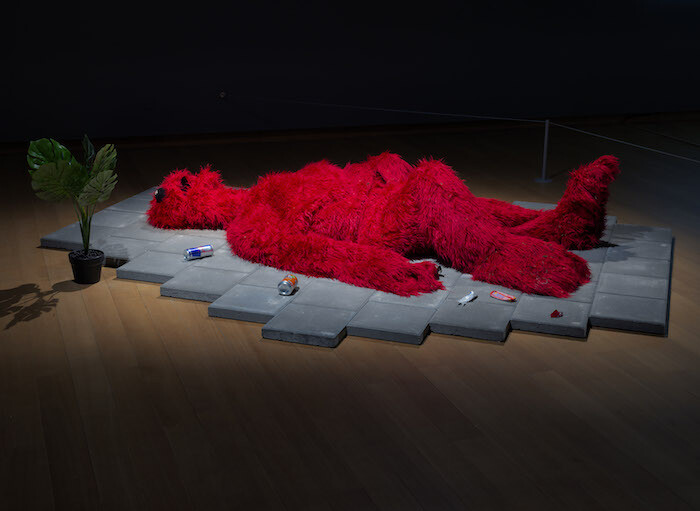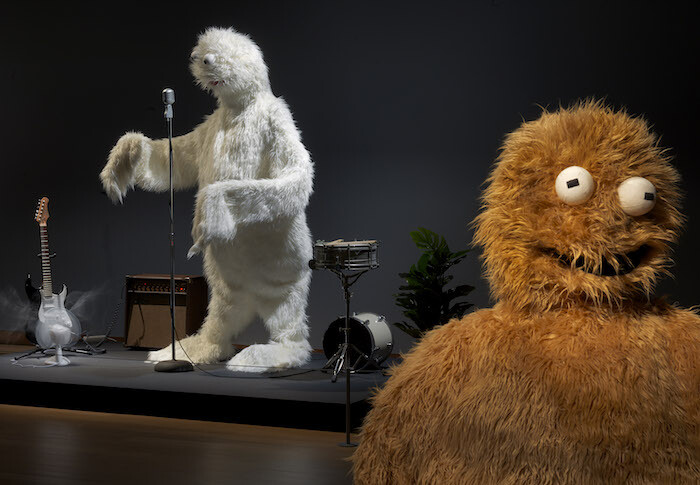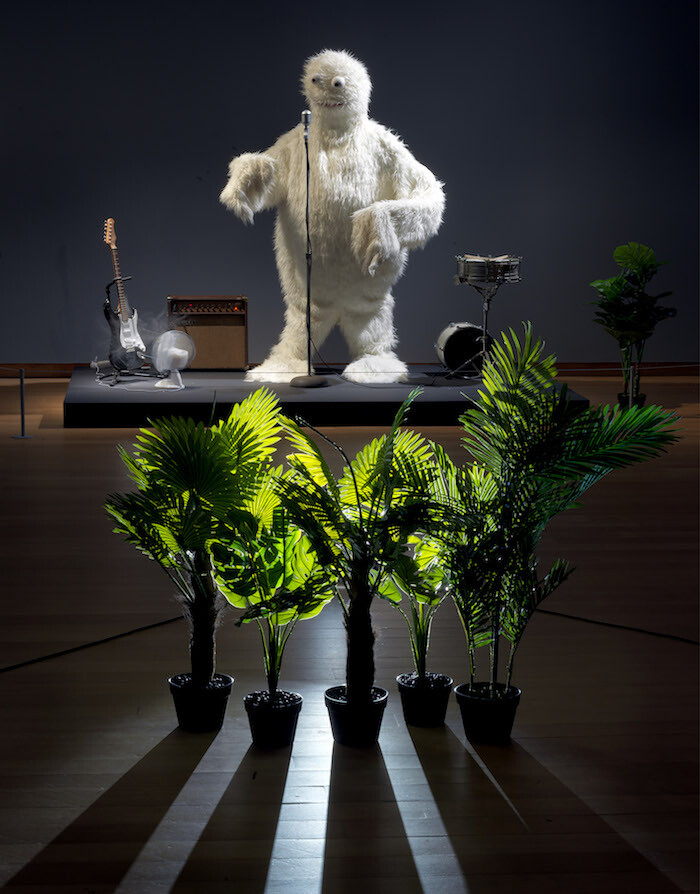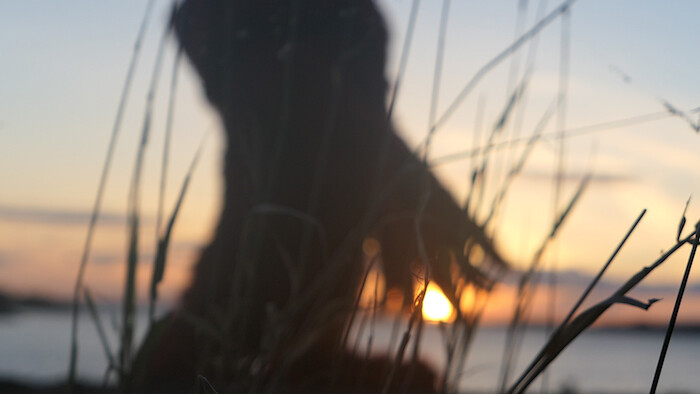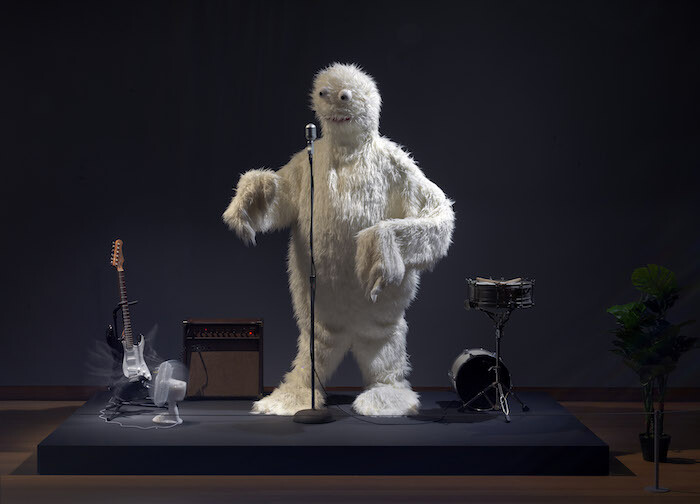It’s hard to think of another Muppet, or any other fictional character, with so streamlined a motivation as the Cookie Monster. Debuting in the kids’ TV show Sesame Street in 1969, this bug-eyed, blue-furred humanoid has spent almost five decades in the relentless pursuit of sugary biscuits, to the exclusion of all else. Notably, the Cookie Monster never actually eats the cookies he crams so voraciously into the dry, felt cavern of his perpetually hungry mouth. Lacking an esophagus, his tragic fate is to chew, but never swallow. Every bite he takes turns to dust, and then spills from his lips. An avatar of appetite, and perhaps of addiction, the Cookie Monster cannot be satiated. He could munch through every cookie on earth and still never experience the giddy high of a sugar rush.
“The Mad Masters,” Stefan Tcherepnin’s solo show at the Stedelijk Museum, appears to ask what would become of this Muppet if he were to attempt to put aside his monomaniacal focus on baked comestibles and search for meaning elsewhere. Entering the gallery space, the viewer encounters four spot-lit sculptural dioramas, in which a series of Cookie Monster–like creatures are displayed in the manner of taxidermied animals in a natural history museum. The first of these, the white-furred Band Leader (all works 2018), stands before a microphone, surrounded by guitars, amps, and drums. It’s not clear whether his bandmates are late for rehearsal or exist only in his mind. The second creature, the brown-furred Channel Surfer, slumps in an easy chair watching TV. Beside him, a wastepaper basket is filled with scrunched-up sketches of his own face. The art of self-portraiture, it seems, has failed him, and now he contemplates his reflection in the flickering screen. The gray-furred, staff-wielding Tilyou Traveler, by contrast, is the outdoors type, gazing on an awesome vista: the arrangement recalls Caspar David Friedrich’s Der Wanderer über dem Nebelmeer [Wanderer above the Sea of Fog] (c. 1818). Rounding off the quartet, the red-furred Crash Survivor lies flat on his back, surrounded by empty packets of Haribo and spent cans of Fanta, as though he’s overdosed on the Cookie Monster equivalent of methadone. Tcherepnin’s creatures are questing after something: an artistic community, self-knowledge, the sublime, or oblivion. The question is what hungers such things satisfy, what wounds they might heal.
Tcherepnin’s accompanying video work, The Mad Masters, also functions as a quest narrative of sorts. The four creatures lumber through a North American landscape, through spring, summer, autumn, and winter, while the soundtrack (composed by Tcherepnin and his frequent collaborator Wally Blanchard) segues from ambient doodlings to squalls of rock guitar. The furry pilgrims wander mutely along snowy, down-at-heel streets, and across the damp lawns of what might be an empty university campus; they crash through sun-strafed forests, and onto the shores of a glittering lake. At its center they see an island, every bit as promising and as forbidding as that depicted in Arnold Böcklin’s painting Die Toteninsel [Isle of the Dead] (1880–86). There’s no ferryman, however, to take these off-brand Muppets across the water. The viewer is left wondering what spirit has guided them here and no further.
One answer is provided by the stylized clown’s face that haunts the film, and reappears as Funny Face Reconstruction—a flat, colored glass sculpture, suspended from the gallery’s ceiling like an occult amulet. Resembling Batman’s nemesis the Joker, this visage is lined with traces of a hypothetical (and nearly impossible to make out) map of an America ravaged by climate change, and overlaid with details of Kazimir Malevich’s 1915 painting Suprematism: Self-Portrait in Two Dimensions. Is Tcherepnin’s point the indivisibility of future and past, despair and hope, dystopian and utopian visions? The work offers such questions up with a smile that is part kids’ entertainer, part murderous comic book psychopath, and all Cheshire Cat.
If Funny Face Reconstruction is the trickster god presiding over the show, who are its titular “Mad Masters”? It’s tempting to say the not-quite-Cookie Monsters, although they, of course, are really stand-ins for our own, equally absurd species, which may have mastered the planet but has still to master its rapacious appetites. Watching Tcherepnin’s creatures gaze across the lake at that distant island, viewers might ponder what thoughts are passing through their heads. Is another world, a better world, there for the taking? Or are they simply thinking “Me want cookie!,” repeated on an infinite loop?



